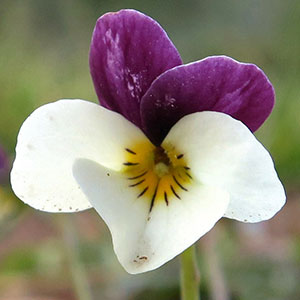|
Hall's violet, Oregon violet, wild pansy
|
field pansy, violette de Rafinesque, wild pansy
|
| Plants perennial, caulescent, not stoloniferous, 5–22 cm. |
|
1–3, decumbent or ascending to erect, ca. 1/2 subterranean, glabrous, clustered on single, short, vertical, deep-seated caudex. |
|
basal and cauline; basal: 1–4, palmately compound, ± 2-ternate or 3-ternate, leaflets 3; stipules adnate to petiole, forming 2 linear-lanceolate wings, unlobed, margins entire, apex of each wing free, acute; petiole 5–8 cm, glabrous; blade ovate to deltate, 2.8–6 × 2.6–6.5 cm, ± coriaceous, base tapered, ultimate lobes narrowly elliptic, lanceolate, or oblanceolate, 1–7 mm wide, margins entire, ciliate or eciliate, apex acute, mucronulate, surfaces glabrous; cauline similar to basal except: stipules usually lanceolate, sometimes broadly ovate, ± leaflike, margins toothed; petiole 1.3–6 cm; blade 2–4.8 × 1.2–5.5 cm. |
|
2.5–11 cm, glabrous. |
1–4.5 cm, glabrous or pubescent. |
sepals lanceolate to ovate, margins ciliate, auricles 0.5–1 mm; petals: upper 2 almost black abaxially, dark reddish violet adaxially, lower 3 pale yellow, cream, or ± white, lateral 2 bearded, with deep yellow to orange patch basally, dark reddish violet-veined, lowest with deep yellow to orange patch basally, dark reddish violet-veined, 5–18 mm, spur yellow, gibbous, 0.5–2 mm; style head bearded; cleistogamous flowers absent. |
sepals ovate to lanceolate, margins ciliate or eciliate, auricles 0.5–2 mm; petals white or cream to pale bluish violet on both surfaces, dark purple-veined, lateral 2 longer than sepals, bearded, lowest 8–10 mm, spur white to blue-violet, gibbous, 1–1.5 mm, shorter than or equaling sepal auricles; style head bearded; cleistogamous flowers axillary. |
ellipsoid, 4–12 mm, glabrous. |
ellipsoid to oblong, 4–7 mm, glabrous. |
light brown, shiny, 3.2–3.5 mm. |
beige to bronze, 0.3–1.5 mm. |
= 60, 72. |
= 34. |
|
|
|
|
| Flowering Apr–Jul. |
Flowering Mar–May. |
| Open forests, grassy hills, chaparral, frequently serpentine or gravelly soil |
Prairies, open woodlands, fields, pastures, roadsides, lawns, waste ground |
| 500–2100 m (1600–6900 ft) |
0–3000 m (0–9800 ft) |
|
CA; OR
|
AL; AR; AZ; CO; CT; DC; DE; FL; GA; IA; ID; IL; IN; KS; KY; LA; MA; MD; MO; MS; NC; NE; NJ; NM; NY; OH; OK; PA; RI; SC; SD; TN; TX; VA; WV; ON; SK
|
Viola hallii was discovered on the grounds of Willamette University in Salem, Oregon, by Elihu Hall, a professor at that institution (V. B. Baird 1942). Leaves of V. hallii are similar to V. beckwithii. (Discussion copyrighted by Flora of North America; reprinted with permission.) |
Viola bicolor is the only pansy native to North America (V. B. Baird 1942; J. Clausen et al. 1964; A. E. Radford et al. 1968) and is the only annual Viola species that produces cleistogamous flowers (Baird; A. Gershoy 1934). Roots of V. bicolor have the odor of wintergreen when crushed (W. J. Hayden and J. Clough 1990). (Discussion copyrighted by Flora of North America; reprinted with permission.) |
| FNA vol. 6, p. 133. |
FNA vol. 6, p. 122. |
| Violaceae > Viola |
Violaceae > Viola |
V. adunca, V. affinis, V. arvensis, V. bakeri, V. beckwithii, V. bicolor, V. biflora, V. blanda, V. brittoniana, V. canadensis, V. canina, V. charlestonensis, V. clauseniana, V. cucullata, V. cuneata, V. douglasii, V. egglestonii, V. epipsila, V. flettii, V. frank-smithii, V. glabella, V. guadalupensis, V. hastata, V. hirsutula, V. howellii, V. japonica, V. labradorica, V. lanceolata, V. langsdorffii, V. lithion, V. lobata, V. macloskeyi, V. missouriensis, V. nephrophylla, V. novae-angliae, V. nuttallii, V. ocellata, V. odorata, V. orbiculata, V. palmata, V. palustris, V. pedata, V. pedatifida, V. pedunculata, V. pinetorum, V. praemorsa, V. primulifolia, V. prionantha, V. pubescens, V. purpurea, V. quercetorum, V. renifolia, V. riviniana, V. rostrata, V. rotundifolia, V. sagittata, V. selkirkii, V. sempervirens, V. septemloba, V. sheltonii, V. sororia, V. striata, V. subsinuata, V. tomentosa, V. tricolor, V. trinervata, V. tripartita, V. umbraticola, V. utahensis, V. vallicola, V. villosa, V. walteri |
V. adunca, V. affinis, V. arvensis, V. bakeri, V. beckwithii, V. biflora, V. blanda, V. brittoniana, V. canadensis, V. canina, V. charlestonensis, V. clauseniana, V. cucullata, V. cuneata, V. douglasii, V. egglestonii, V. epipsila, V. flettii, V. frank-smithii, V. glabella, V. guadalupensis, V. hallii, V. hastata, V. hirsutula, V. howellii, V. japonica, V. labradorica, V. lanceolata, V. langsdorffii, V. lithion, V. lobata, V. macloskeyi, V. missouriensis, V. nephrophylla, V. novae-angliae, V. nuttallii, V. ocellata, V. odorata, V. orbiculata, V. palmata, V. palustris, V. pedata, V. pedatifida, V. pedunculata, V. pinetorum, V. praemorsa, V. primulifolia, V. prionantha, V. pubescens, V. purpurea, V. quercetorum, V. renifolia, V. riviniana, V. rostrata, V. rotundifolia, V. sagittata, V. selkirkii, V. sempervirens, V. septemloba, V. sheltonii, V. sororia, V. striata, V. subsinuata, V. tomentosa, V. tricolor, V. trinervata, V. tripartita, V. umbraticola, V. utahensis, V. vallicola, V. villosa, V. walteri |
|
V. kitaibeliana var. rafinesquei, V. rafinesquei |
| A. Gray: Proc. Amer. Acad. Arts 8: 377. (1872) |
Pursh: Fl. Amer. Sept. 1: 175. (1813) |
| |


